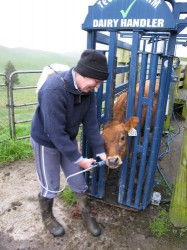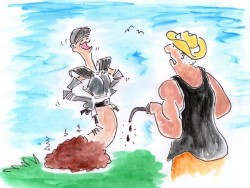Wisdom Needed to Tackle Worm Resistance.
by Barry Easton

A scientific study has turned conventional wisdom related to worm control on its head!
The study was initiated on ‘Totara Mahanga’, the Inglewood property of New Zealand Grazing Company managing director, Ian Wickham, last autumn. It sought to determine the extent of worm resistance among dairy heifers given a range of treatments, and as a result, the best means of combating worm resistance.
The study was initiated by two Inglewood veterinarians – Peter Benn, and Jonathan Spencer, BVMS.
Conclusions reached as a result of the study were:
- When stock are being drenched, a percentage of the mob (about 10%) should be left undrenched.
- After drenching, stock should not be returned to clean pasture, but instead to a worm contaminated pasture.
- No drench kills 100% of worms.
- Combination drenches should be used – the study showed these to be the most effective.
- Stock should not be drenched religiously every month, but only when necessary. Ideally this should be when faecal egg counts reach 250 epg (eggs per gram) or when cattle show reduced weight gain.
- Young cattle should be alternated with older cattle or another species – sheep if possible – since different worm species affect different animal species and they will kill each other’s worms.
- Rising two-year-old cattle and older cattle should not be drenched they don’t need it.
- The situation should be reviewed in 12 months with another drench test.
Benn and Spencer’s study took place from June 8 until June 22, 2006.
Home Farm is First Study
“Given Ian Wickham’s position as managing director of the New Zealand Grazing Company, it was felt that we should ascertain the position related to drench resistance on his home farm,” says the report.
“Almost exclusive use of white drenches had been made on Ian’s farm for a number of years. Conveniently, among his grazing clients in the autumn of 2006, Ian had one with a mob of 110 heifers which were suitable for a study to compare different drench families with each other, and with no drench.”
Four weeks after the heifers had last been drenched, faecal worm egg counts were performed on dung pat samples. These were taken weekly – and the trial was delayed – until a faecal egg count of 173 eggs per gram was reached.
Seven groups of heifers, with 15 animals in each group, were used in the evaluation. One group – the control group – was not drenched at all. Others were dosed according to their liveweights with white drench (benzimidazole), clear drench (levamisole), white/clear combination drench, endectocide (macrocyclic lactone), half dose endectocide, and endectocide/levamisole combinations.
| Performed at Ian Wickhams farm on Tarata Rd Inglewood 08/06-22/06-2006 | |||||||
|---|---|---|---|---|---|---|---|
| Group Name | Group 1 | Group 2 | Group 3 | Group 4 | Group 5 | Group 6 | Group 7 |
| Group colour | Orange | Green | Blue | Yellow | Red | Pink | No Colour |
| Drench Type | Lev | BZ | BZ/Lev | ML/Lev | ML | ML-1/2 | None |
| Dose rate | 3ml/16kg | 1ml/20kg | 1ml/10kg | 1ml/20kg | 1ml/20kg | 1ml/40kg | N/A |
| No. in Group | 15 | 15 | 15 | 15 | 15 | 15 | 16 |
| Date Treated | Jun 08 | Jun 08 | Jun 08 | Jun 08 | Jun 08 | Jun 08 | Jun 08 |
| Date FEC Sampled | Jun 22 | Jun 22 | Jun 22 | Jun 22 | Jun 22 | Jun 22 | Jun 22 |
| Strong Nem | Strong Nem | Strong Nem | Strong Nem | Strong Nem | Strong Nem | Strong Nem | |
| Pre-drench FEC | 173 0 | 173 0 | 173 0 | 173 0 | 173 0 | 173 0 | 173 0 |
| Post-drench FEC | 30 0 | 170 0 | 0 0 | 0 0 | 0 0 | 30 0 | 340 0 |
| %Effective | 82.7 | 1.7 | 100.0 | 100.0 | 100.0 | 82.7 | -96.5 |
| %Resistant | 17.3 | 98.2 | 0.0 | 0.0 | 0.0 | 17.3 | 196.5 |
| Post-drench Larval Culture | Ostertagia 99% | 5% | 0% | 0% | 0% | 0% | 5% |
| Trich 1% | 0% | 0% | 0% | 0% | 0% | 12% | |
| Cooperia 0.0% | 95% | 0.0% | 0.0% | 0.0% | 100% | 83% | |
| Weight gain kg/day before Drench | 0.24 | 0.23 | 0.24 | 0.26 | 0.21 | 0.25 | 0.32 |
| Weight gain kg/day After Drench | 0.47 | 0.29 | 0.52 | 0.39 | 0.49 | 0.36 | 0.32 |
Individual dung samples
Two weeks later, all test animals were individually dung sampled. Faecal worm egg counts were checked and any animals with less than 95% reduction in the faecal egg count were regarded as showing resistance to the drench.
They were submitted for larval culture to ascertain the species of resistant worms. “Drug resistance in the different gastrointestinal worm species were shown,” says the report.
“Ostertagia worms showed significant resistance to both white and clear drench, and Cooperia worms showed major resistance to white drench and emerging resistance to endectocide. Resistance was not apparent in either of the combinations or in the full dose of endectocide.”
Weight gains
Weight gains recorded during the study require careful interpretation, says the report.
“The levamisole treated group had good weight gains in spite of showing Ostertagia resistance, which was not surprising at that time of the year when Ostertagia are less significant.”
“The benzimidazole treated group had the poorest weight gains, which were poorer than the control group.”
“The highest weight gains were recorded in the benzimidazole/levamisole treated combination group.”

Drench resistance is a fact – not a fiction
The study gives cause for worry, in that the results indicate a rapidly shrinking arsenal of worm drenches at the disposal of farmers, says Benn and Spencer.
“We must do all that we can to conserve what we have left,” they urge.
“It would seem logical that resistance to white drench has occurred through persistent use on the home farm, whilst that to clear drench and endectocides may well have been brought on to the farm by worm-infested heifers.”
“In conclusion, this drench test clearly illustrates the widely held view that drench resistance is a fact, not a fiction, and unfortunately will not go away.”
